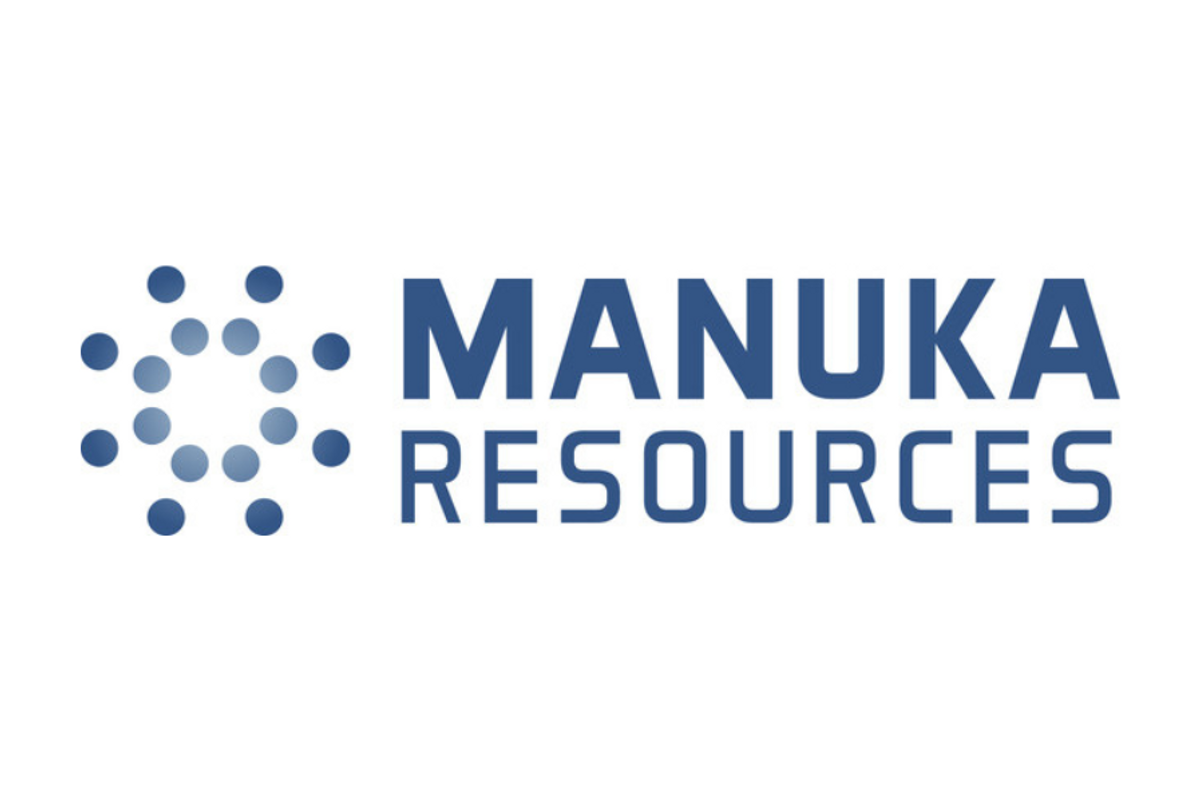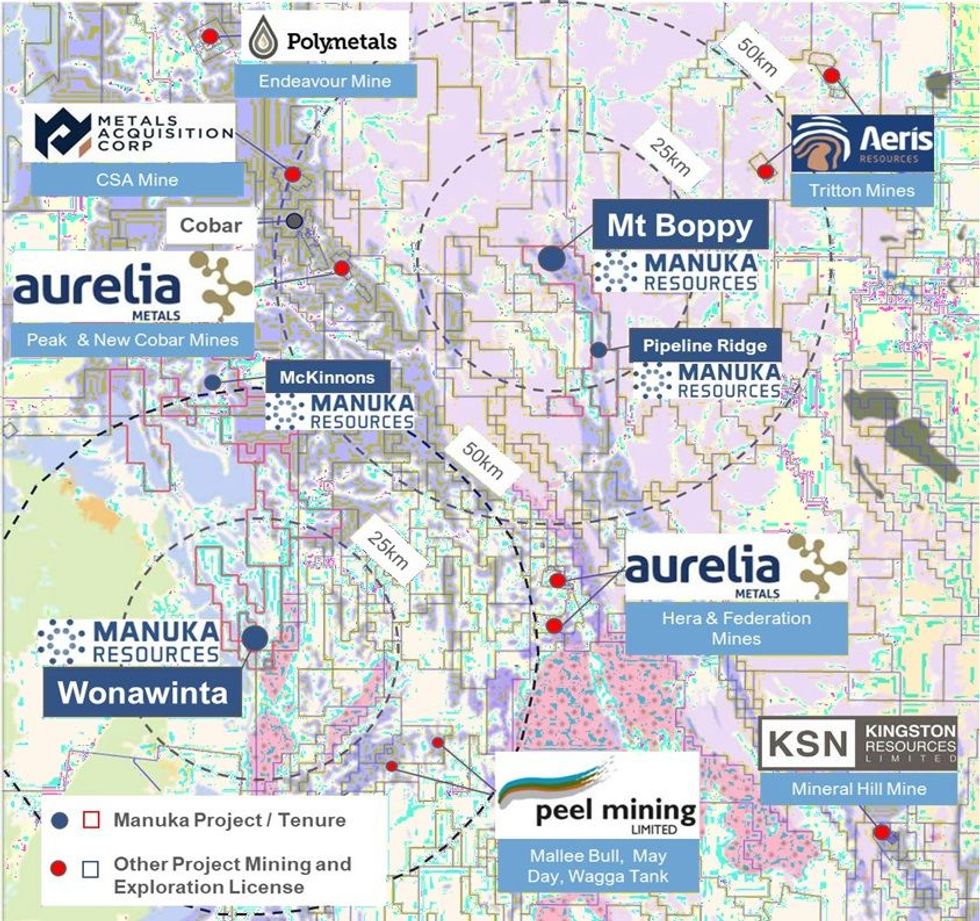
August 11, 2024
Manuka Resources Limited (“Manuka” or the “Company”) is pleased to provide a progress update on the restart of gold doré production from its 100% owned Mt Boppy gold mine (“Mt Boppy”) located in the Cobar Basin, NSW (Figure 1).
Highlights
- Manuka is executing a strategy to construct a fit-for-purpose processing and gold doré production facility at its 100% owned Mt Boppy gold mine.
- Previously, ore from Mt Boppy had been hauled to and processed at the Company’s CIL plant located at the Wonawinta Silver Mine (“Wonawinta”) 150km south of Mt Boppy.
- Mt Boppy is forecast to be a low capex (A$11.6M), high margin (~A$19M EBITDA per annum) operation1.
- Relocation of the existing 400kW ball mill located at Wonawinta to Mt Boppy has commenced. The ball mill is surplus to requirements at Wonawinta where a 1800kW ball mill has been previously installed.
- Acquisition of a second-hand Inline Pressure Jig (IPJ) and Intensive Leach Reactor (ILR) has resulted in approximately A$850k savings versus that originally budgeted. The purchased equipment is currently undergoing refurbishment at Gekko Systems, the original equipment manufacturer.
- The Company is currently investigating opportunities to increase milling capacity and accelerate gold production at Mt Boppy.
- The Company is targeting first gold production from Mt Boppy in Q4 2024.
Dennis Karp, Manuka’s Executive Chairman, commented:
“The execution of our plan to restart gold operations at Mt Boppy is well underway.
The opportunistic purchasing of selected second-hand processing equipment is consistent with our low capex strategy that includes the leveraging and repurposing of existing assets including the Wonawinta 400kW ball mill, diesel generators, 48-man accommodation camp and mobile screening plant.
We look forward to providing regular updates to the markets as we progress towards first gold production at Mt Boppy.

Background
The Mt Boppy gold mine is an existing gold operation comprising a brownfields open pit and associated historic ROM stockpiles, rock dumps and tailings.
In April 2024, Manuka announced a strategy whereby a fit-for-purpose processing and gold production facility would be established at Mt Boppy for a capital cost A$11.6M to generate an average EBITDA of ~A$19M per annum over an initial 5-year period2.
A sonic drilling program over the Main Rock Dump and Tailings Storage Facility 3 (“TSF3”) was completed in late 2023 which improved confidence in Resource3 grade and ore type distribution and underpins the updated production strategy.
Previously, ore mined by Manuka at Mt Boppy had been hauled 150km to the CIL process plant located at Wonawinta at a cost of ~A$27/t. The updated strategy of on- site processing is expected to save in the order of A$7M per annum.
Click here for the full ASX Release
This article includes content from Manuka Resources Limited, licensed for the purpose of publishing on Investing News Australia. This article does not constitute financial product advice. It is your responsibility to perform proper due diligence before acting upon any information provided here. Please refer to our full disclaimer here.
MKR:AU
The Conversation (0)
26 March 2025
Manuka Resources
Near-term production from both its silver and gold projects located in the Cobar Basin, Central West, New South Wales
Near-term production from both its silver and gold projects located in the Cobar Basin, Central West, New South Wales Keep Reading...
05 August 2025
Results of Fully Underwritten Entitlement Offer
Manuka Resources (MKR:AU) has announced Results of Fully Underwritten Entitlement OfferDownload the PDF here. Keep Reading...
31 July 2025
June 2025 Quarter Activities and Cashflow Reports
Manuka Resources (MKR:AU) has announced June 2025 Quarter Activities and Cashflow ReportsDownload the PDF here. Keep Reading...
29 July 2025
Maiden Mt Boppy Open Pit Ore Reserve
Manuka Resources (MKR:AU) has announced Maiden Mt Boppy Open Pit Ore ReserveDownload the PDF here. Keep Reading...
10 July 2025
Further Information to 26 June Announcement
Manuka Resources (MKR:AU) has announced Further Information to 26 June AnnouncementDownload the PDF here. Keep Reading...
08 July 2025
$8 Million Fully Underwritten Entitlement Offer
Manuka Resources (MKR:AU) has announced $8 Million Fully Underwritten Entitlement OfferDownload the PDF here. Keep Reading...
5h
Yvonne Blaszczyk: Gold Still Far from "Ultimate High," US$5,000 is Next
Yvonne Blaszczyk, president and CEO of BMG Group, sees the gold price hitting US$5,000 per ounce in Q1 on the back of a complex geopolitical landscape. "In terms of the geopolitical configuration of the world, we are witnessing history right now," she said. Don't forget to follow us... Keep Reading...
7h
One Bullion Limited Closes the Market
Adam Berk, Chief Executive Officer and President, One Bullion Limited, ("One Bullion" or the "Company") (TSXV: OBUL) and its executive management team, joined Dean McPherson, Head, Business Development, Global Mining, Toronto Stock Exchange ("TSX"), to close the market and celebrate the... Keep Reading...
8h
Blackrock Silver Closes C$15 Million Private Placement Led By a C$7 Million Investment from Eric Sprott
Blackrock Silver Corp. (TSXV: BRC,OTC:BKRRF) (OTCQX: BKRRF) (FSE: AHZ0) ("Blackrock" or the "Company") is pleased to announce the completion of its non-brokered private placement (the "Offering") previously announced on December 24, 2025. 2176423 Ontario Ltd., a company beneficially owned by... Keep Reading...
18h
Harvest Gold Identifies Significant AU-AG-CU Halo Associated With The Structural / Magnetic Feature On Mosseau
(TheNewswire) Vancouver, British Columbia / January 8, 2026 ‑ TheNewswire - Harvest Gold Corporation (TSXV: HVG,OTC:HVGDF) ("Harvest Gold" or the "Company") is pleased to announce the second series of assay results from its maiden drill program at its Mosseau property in the Urban Barry Belt in... Keep Reading...
07 January
Alain Corbani: Gold to Hit US$5,000 Near Term, What About Silver?
Alain Corbani, head of mining at Montbleu Finance and manager of the Global Gold and Precious Fund, sees the gold price reaching US$5,000 per ounce in the near term. He sees real interest rates and the US dollar as the key factors to watch, but noted that other elements are also adding... Keep Reading...
Latest News
Interactive Chart
Latest Press Releases
Related News
TOP STOCKS
American Battery4.030.24
Aion Therapeutic0.10-0.01
Cybin Corp2.140.00







